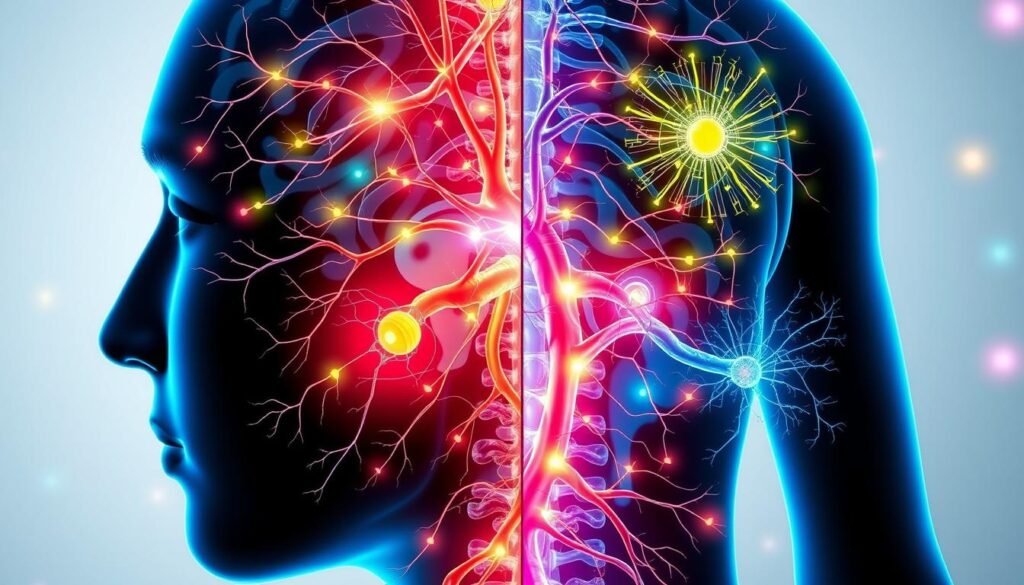Chronic pain is more than just physical pain. It changes how we live every day. It affects about 20.4% of adults in the U.S. and lasts more than three months. It makes it hard to work, socialize, and keep relationships strong.
People with chronic pain often look fine but feel terrible inside. This makes it hard for others to understand what they’re going through.
Chronic pain does more than just hurt. It makes you tired, keeps you awake at night, and messes with your mood. It can even weaken your immune system and make moving harder. This can make you feel trapped, anxious, or sad.
Key Takeaways
- Chronic pain is a debilitating condition that affects over 20% of adults in the United States.
- Chronic pain can have a significant impact on physical, mental, and emotional well-being, causing fatigue, sleep disturbances, and feelings of helplessness.
- The invisible nature of chronic pain can lead to misconceptions and a lack of understanding from others.
- Managing chronic pain requires a multifaceted approach, including physical therapies, psychological support, and social connections.
- Improving quality of life with chronic pain involves addressing the physical, mental, and social challenges associated with the condition.
Understanding Chronic Pain vs Acute Pain
Chronic pain and acute pain are two different kinds of pain. Acute pain is a short-term response to injury or illness, lasting a few days or weeks. Chronic pain, however, lasts for months or even years, affecting daily life.
Defining Pain Duration and Types
Acute pain is short, lasting under three months. Chronic pain goes on for more than three to six months. This long-term pain can cause fatigue, sleep issues, and mental health problems.
Pain Signal Processing in the Body
Chronic pain is different because of how the brain and nerves handle pain signals. The nervous system changes, sending pain signals even when there’s no harm. This makes treating chronic pain harder with just medicine.
Common Causes of Chronic Pain
- Arthritis
- Nerve damage
- Fibromyalgia
- Back pain
- Headaches
- Cancer-related pain
Many conditions can cause chronic pain. Managing it often needs a team effort. This includes medicine, physical therapy, and other treatments.

“Chronic pain can have a significant impact on an individual’s daily life, affecting their physical, mental, and social well-being. Understanding the differences between chronic and acute pain is crucial for developing appropriate treatment strategies.”
Impact of Chronic Pain on Daily Life
Chronic pain can really change how we live our daily lives. It makes moving around harder and can make us need help more often. Even simple tasks, like making tea, can become a big challenge.
Because of chronic pain, doing everyday things can be tough. It’s hard to keep up with regular routines and finish tasks.
Physical Limitations and Mobility Issues
Chronic pain can limit how we move. It can make our muscles weak and affect our balance. These problems make basic tasks, like getting dressed or taking a bath, hard to do.
Not being able to move easily can make us feel like we’re losing our independence. We might need to rely more on others for help.
Effects on Daily Tasks and Routines
Chronic pain can mess up our daily routines. Simple tasks, like cleaning or shopping, can feel overwhelming. We might need to plan our day carefully to save energy.
This can make our life feel less fulfilling. We might feel like we’re losing our independence.
Work and Professional Life Changes
Chronic pain can also affect our work lives. Many people find it hard to keep their jobs or need special help at work. This can lead to less productivity and more time off.
The chronic pain and work productivity issues can cause financial problems. It can also make us feel like we’ve lost our purpose or identity.
Dealing with chronic pain in our daily lives needs a big effort. We need to use strategies like pacing, adapt to our situation, and practice mindfulness. By tackling the physical, practical, and emotional sides of chronic pain, we can try to stay independent and manage our symptoms better.

“The invisible nature of chronic pain can make it difficult for others to understand the true extent of its impact on our daily lives.”
The Hidden Nature of Chronic Pain
Chronic pain is often invisible, leading to many misunderstandings. People with chronic pain may look fine but struggle deeply inside. This hidden pain can cause emotional distress and feelings of isolation.
Recent studies show that chronic widespread pain affects 10% of adults. It can make everyday life very hard. The study included eight people aged 40-60 with CWP. All but one had to stop working because of their health.
It’s hard for others to understand and empathize with chronic pain. This can strain relationships and social interactions. One study participant said, “People just can’t see the pain I’m in, so they think I’m making it up or that it’s not that bad.”
“People just can’t see the pain I’m in, so they think I’m making it up or that it’s not that bad.”
The study also found that people with severe chronic pain have a higher risk of death. Death from heart or respiratory disease is twice as common in those with severe pain. This shows how chronic pain can affect overall health and well-being.
The invisibility of chronic pain contributes to misconceptions and stigma. By raising awareness, we can create a more supportive environment. This will help those living with this invisible illness.

Mental Health Challenges and Emotional Impact
Chronic pain can really hurt a person’s mental health. It often leads to serious issues like depression and anxiety. The fear of pain coming back and not being able to do things can make people feel trapped and helpless.
Depression and Anxiety
Studies show that people with chronic pain are four times more likely to have depression or anxiety. Conditions like osteoarthritis, fibromyalgia, and chronic migraines are linked to mental health problems. Up to 45% of those with chronic pain have depression, and 47% show signs of severe depression.
Stress Management Strategies
Managing stress is key for those with chronic pain. Techniques like cognitive-behavioral therapy and mindfulness can help. These methods help people deal with pain-related anxiety and depression by changing how they think and feel.
Psychological Coping Mechanisms
It’s important to find ways to cope with chronic pain mentally. This can include talking to mental health professionals, building a support network, and doing things that bring joy. By tackling the emotional side of chronic pain, people can live better lives and manage their condition more effectively.
| Condition | Mental Health Impacts | Coping Strategies |
|---|---|---|
| Osteoarthritis | Increased risk of depression and anxiety | Cognitive-behavioral therapy, exercise, pain management techniques |
| Fibromyalgia | Five times higher risk of anxiety disorders, including obsessive-compulsive disorder | Mindfulness practices, stress reduction techniques, support groups |
| Multiple Sclerosis | Nearly twice as likely to experience Major Depressive Disorder, 36% risk of anxiety | Psychotherapy, medication, social support, physical activity |
| Chronic Migraines | More common in individuals with a history of trauma, can trigger acute anxiety | Relaxation exercises, trigger identification, mental health counseling |

“Chronic pain and mental health conditions often go hand-in-hand. By addressing the emotional and psychological aspects of chronic pain, individuals can find more effective ways to manage their condition and improve their overall quality of life.”
Sleep Disturbances and Fatigue Management
People with chronic pain often struggle with sleep and energy. Chronic pain and sleep problems create a cycle that worsens both. Studies show that 67% to 88% of those with chronic pain have trouble sleeping, and 50% of those with insomnia also have chronic pain.
Some chronic pain conditions, like rheumatoid arthritis and fibromyalgia, lead to sleep issues in up to 95% of cases. Poor sleep makes pain worse and can lead to depression, anxiety, and even suicidal thoughts. Research shows sleep deprivation makes pain more intense, and insomnia can lead to chronic pain.
It’s key to tackle chronic pain and sleep disturbances to improve well-being. Good sleep hygiene and relaxation methods like meditation can help. Some might need special sleep programs to meet their needs.
| Sleep Disorder | Prevalence in Chronic Pain Patients |
|---|---|
| Insomnia | 72% – 75% |
| Restless Legs Syndrome | 14% – 23% |
| Obstructive Sleep Apnea | 3% – 24% |
By tackling chronic pain and sleep disturbances, people can improve sleep, manage fatigue, and enhance their life quality.
Social Relationships and Support Systems
Chronic pain can really affect how we connect with others. It makes it hard to keep up with family and friends. It’s key to have a strong support system to handle chronic pain well.
Family Dynamic Changes
Chronic pain changes family roles and duties. The person with pain might need more help with everyday tasks. This can cause tension and make relationships strained.
It’s important to talk openly and be understanding. Working together as a family is crucial to stay close during tough times.
Maintaining Friendships
Keeping friendships alive with chronic pain is tough. It’s hard to join in on social activities. Friends might not get what it’s like to live with pain.
Trying to stay in touch, like through online meetings, can help. It keeps friendships alive even when you can’t meet up in person.
Building Support Networks
Having a strong support system is vital for dealing with chronic pain. Joining support groups can connect you with others who understand. It’s a place to share experiences and get advice.
Talking to mental health experts can also offer a lot of help. They can guide you through the emotional side of chronic pain. Teaching loved ones about your condition can also help them understand and support you better.
“Chronic pain can be an isolating experience, but building a supportive network of family, friends, and professionals can make a world of difference in managing its challenges.”
Physical Activity and Exercise Adaptations
Managing chronic pain often requires a holistic approach, and regular physical activity plays a crucial role. Many individuals with chronic pain may be hesitant to exercise due to fear of exacerbating their symptoms. However, being physically inactive can actually worsen their condition in the long run.
Incorporating tailored exercise routines and pacing techniques can help individuals with chronic pain gradually increase their activity levels without causing flare-ups. This approach allows them to gradually increase their physical activity while carefully monitoring their body’s response and adjusting as needed.
Suitable exercises for individuals with chronic pain may include low-impact activities such as walking, dancing, pool exercises, or gentle stretching. It’s essential to start slowly and gradually increase the intensity and duration of the exercises as the body adapts. Working with a physical therapist or healthcare provider can help develop a personalized exercise plan that takes into account the individual’s specific needs and limitations.
| Exercise Type | Benefits | Considerations |
|---|---|---|
| Walking | Improves cardiovascular health, strengthens muscles, and can be adapted to different pain levels. | Start with short, manageable distances and gradually increase duration and pace. |
| Pool Exercises | Reduces joint stress, improves mobility, and can be performed with minimal pain. | Ensure the water temperature is comfortable and the exercises are tailored to individual needs. |
| Gentle Stretching | Enhances flexibility, range of motion, and can provide pain relief. | Avoid overstretching and focus on gentle, controlled movements. |
By incorporating physical activity adaptations and exercise for chronic pain into their daily routine, individuals with chronic pain can experience improved physical and mental well-being. They can also see reduced symptom severity and enhanced overall quality of life.
Treatment Approaches and Pain Management
Managing chronic pain often needs a mix of methods. Medications can help, but they’re not always enough. Chronic pain involves complex brain and body processes that meds can’t fully tackle.
Medication Options
There are many pain meds, like acetaminophen and NSAIDs. Sometimes, antidepressants or other drugs are used too. But, using opioids for long periods is usually not recommended because they’re not very effective and can cause serious side effects.
Alternative Therapies
Therapies like acupuncture, massage, and mindfulness can help with chronic pain. They focus on the physical, emotional, and mental sides of pain. This makes pain management more complete.
Lifestyle Modifications
Changing your lifestyle is key to managing chronic pain. Reducing stress, eating better, and getting more sleep can really help. Pain management programs often teach these lifestyle changes to improve how people feel and function.
Combining meds, alternative therapies, and lifestyle changes can effectively tackle chronic pain. This approach can greatly improve the lives of those dealing with chronic pain.
| Treatment Approach | Description | Potential Benefits |
|---|---|---|
| Medication | Over-the-counter pain relievers, prescription medications, and antidepressants | Provides targeted pain relief, can be part of a comprehensive treatment plan |
| Alternative Therapies | Acupuncture, massage, mindfulness, and other complementary approaches | Addresses physical, emotional, and psychological aspects of pain; promotes holistic well-being |
| Lifestyle Modifications | Stress reduction techniques, dietary changes, and improved sleep habits | Empowers individuals to self-manage pain and improve overall quality of life |
“Pain management encompasses a variety of approaches including medications, procedures, exercises, and therapy to regulate and relieve pain.”
Quality of Life Improvements
Living with chronic pain is tough, but you can manage it. Setting goals and pacing yourself helps you feel in control. This way, you can keep up with your daily life.
Doing things you enjoy, even if they’re different, lifts your mood. It helps distract you from pain. Stress management, like mindfulness, is also key for feeling good.
It’s important to stay connected and have a strong support network. Talking to loved ones and joining groups helps. It makes you feel less alone and understood.
Improving your life with chronic pain means focusing on what you can do. Celebrate small wins and stay flexible. This keeps you motivated to manage your pain well.
Being grateful and finding joy in simple things boosts your well-being. Embracing a wide range of strategies helps you improve your quality of life with chronic pain. It also helps you find effective chronic pain coping strategies.
“The secret of change is to focus all of your energy, not on fighting the old, but on building the new.” – Socrates
Conclusion
Living with chronic pain is a complex journey that affects many parts of life. Studies show that 10% to 30% of adults in Europe have chronic pain. In Spain, this number is 16.6%.
Chronic pain does more than just hurt physically. It also impacts mental health, social relationships, and daily life. This makes it hard to function normally.
But, there’s hope. A mix of medical treatments, lifestyle changes, and psychological support can help. This approach can improve life quality. It helps manage the physical, emotional, and social effects of chronic pain.
With the right help, people with chronic pain can adapt and thrive. They can lead more fulfilling lives, despite the challenges.
Managing chronic pain is key in healthcare. It affects not just the person but also the healthcare system and society. Understanding and addressing chronic pain’s effects is crucial.
Healthcare providers and policymakers must work together. They can improve lives of those with chronic pain. This is essential for better healthcare and society.


